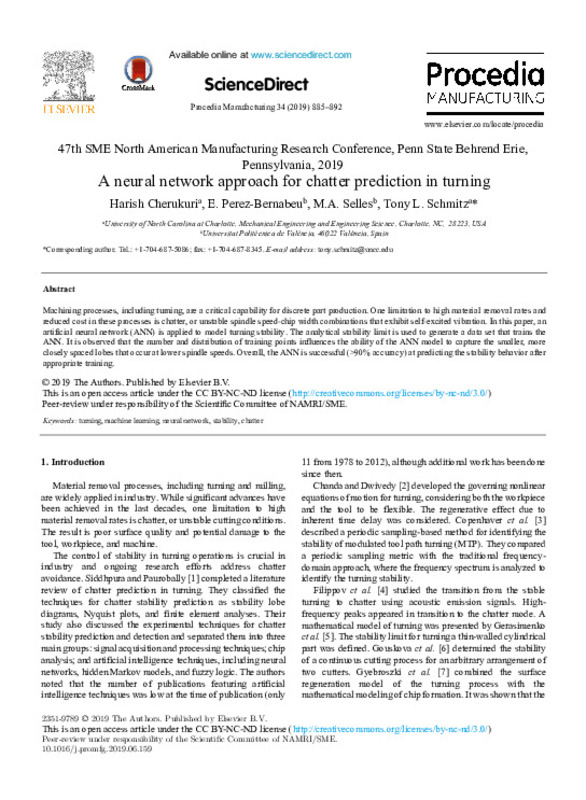JavaScript is disabled for your browser. Some features of this site may not work without it.
Buscar en RiuNet
Listar
Mi cuenta
Estadísticas
Ayuda RiuNet
Admin. UPV
A neural network approach for chatter prediction in turning
Mostrar el registro sencillo del ítem
Ficheros en el ítem
| dc.contributor.author | Cherukuri, Harish
|
es_ES |
| dc.contributor.author | Pérez Bernabeu, Elena
|
es_ES |
| dc.contributor.author | Sellés, M.A.
|
es_ES |
| dc.contributor.author | Schmitz, Tony L.
|
es_ES |
| dc.date.accessioned | 2024-01-12T19:01:51Z | |
| dc.date.available | 2024-01-12T19:01:51Z | |
| dc.date.issued | 2019 | es_ES |
| dc.identifier.uri | http://hdl.handle.net/10251/201888 | |
| dc.description.abstract | [EN] Machining processes, including turning, are a critical capability for discrete part production. One limitation to high material removal rates and reduced cost in these processes is chatter, or unstable spindle speed-chip width combinations that exhibit self-excited vibration. In this paper, an artificial neural network (ANN) is applied to model turning stability. The analytical stability limit is used to generate a data set that trains the ANN. It is observed that the number and distribution of training points influences the ability of the ANN model to capture the smaller, more closely spaced lobes that occur at lower spindle speeds. Overall, the ANN is successful (>90% accuracy) at predicting the stability behavior after appropriate training. | es_ES |
| dc.description.sponsorship | The authors gratefully acknowledge financial support from the UNC ROI program. Elena Perez-Bernabeu and Miguel Selles also acknowledge support from Universitat Politenica de Valencia (PAID-00-17). Additionally, some of the neural net figures and the 10-fold cross validation figures are based on the TikZ codes provided on StackExchange-TeX by various users. Harish Cherukuri would like to thank them for their valuable advice. | es_ES |
| dc.language | Inglés | es_ES |
| dc.publisher | Elsevier | es_ES |
| dc.relation.ispartof | Procedia Manufacturing | es_ES |
| dc.rights | Reconocimiento - No comercial - Sin obra derivada (by-nc-nd) | es_ES |
| dc.subject | Turning | es_ES |
| dc.subject | Machine learning | es_ES |
| dc.subject | Neural network | es_ES |
| dc.subject | Stability | es_ES |
| dc.subject | Chatter | es_ES |
| dc.subject.classification | INGENIERIA DE LOS PROCESOS DE FABRICACION | es_ES |
| dc.subject.classification | ESTADISTICA E INVESTIGACION OPERATIVA | es_ES |
| dc.title | A neural network approach for chatter prediction in turning | es_ES |
| dc.type | Artículo | es_ES |
| dc.type | Comunicación en congreso | es_ES |
| dc.identifier.doi | 10.1016/j.promfg.2019.06.159 | es_ES |
| dc.relation.projectID | info:eu-repo/grantAgreement/UNC System Research Opportunites Innitiative (ROI)//CSAM//North Carolina Consortium for Self-Aware Machining and Metrology (CSAM)/ | es_ES |
| dc.relation.projectID | info:eu-repo/grantAgreement/UPV//PAID-00-17/ | es_ES |
| dc.rights.accessRights | Abierto | es_ES |
| dc.contributor.affiliation | Universitat Politècnica de València. Escuela Politécnica Superior de Alcoy - Escola Politècnica Superior d'Alcoi | es_ES |
| dc.description.bibliographicCitation | Cherukuri, H.; Pérez Bernabeu, E.; Sellés, M.; Schmitz, TL. (2019). A neural network approach for chatter prediction in turning. Procedia Manufacturing. 34:885-892. https://doi.org/10.1016/j.promfg.2019.06.159 | es_ES |
| dc.description.accrualMethod | S | es_ES |
| dc.relation.conferencename | 47th SME North American Manufacturing Research Conference (NAMRC 2019) | es_ES |
| dc.relation.conferencedate | Junio 10-14,2019 | es_ES |
| dc.relation.conferenceplace | Behrend Coll, EEUU | es_ES |
| dc.relation.publisherversion | https://doi.org/10.1016/j.promfg.2019.06.159 | es_ES |
| dc.description.upvformatpinicio | 885 | es_ES |
| dc.description.upvformatpfin | 892 | es_ES |
| dc.type.version | info:eu-repo/semantics/publishedVersion | es_ES |
| dc.description.volume | 34 | es_ES |
| dc.identifier.eissn | 2351-9789 | es_ES |
| dc.relation.pasarela | S\394958 | es_ES |
| dc.contributor.funder | Universitat Politècnica de València | es_ES |
| dc.contributor.funder | UNC System Research Opportunites Innitiative (ROI) | es_ES |








